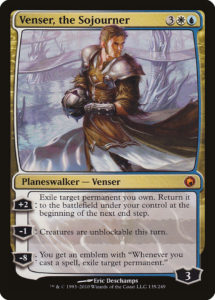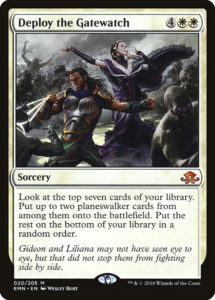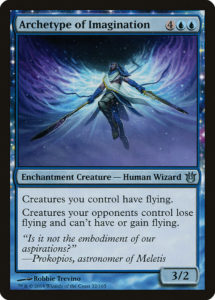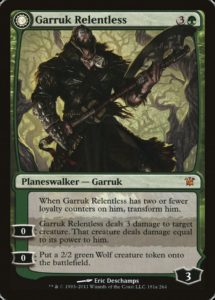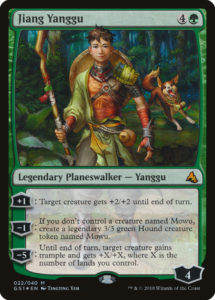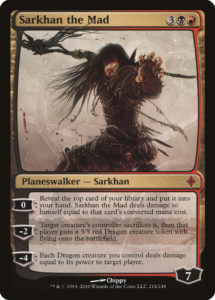War of the Spark promises a whole host of goodies. It’s the first event set—something that seems distinct from a top-down or a bottom-up set—where we’ll see Bolas’ plans come to fruition. It’s the first set designed around a massive conflict starring dozens of Planeswalkers. And unlike Invasion or Time Spiral, it has both modern set design principles to lay its foundation upon and actual Planeswalker cards. Now, we can see our protagonists and antagonists on their own cards, not just noncreature spells like Holy Day and Planeswalker’s Mirth.
This leads us to the big outstanding question of how. How do you fit 36 Planeswalkers into a set, when the previous record is Magic 2015 & 2019’s six? We know from Dominaria that modern printing technology makes possible a dedicated legendary card slot in every pack, and that Wizards R&D can design nuanced and powerful legendaries at uncommon while creating an excellent Limited format. However, Planeswalkers are very different from legendary creatures (and sorceries and artifacts). Sure, they can put a Planeswalker into every pack, but how can that actually work?
Today on Drawing Live, we’ll delve into what Planeswalkers actually are, why designing and balancing them has historically proven difficult, and some strategies Wizards may have employed in War of the Spark.
The Planeswalker Power Problem
If you’ve ever played with or against a Planeswalker, you’ve seen them warp games around themselves. Most games of Magic are about card advantage, board presence, and ultimately getting your opponent from twenty to zero. When a Planeswalker hits the battlefield, the game usually transforms into a subgame of “kill the Planeswalker before it takes over the game,” putting much of the current game on pause. Planeswalkers accomplish this in a variety of ways, but usually by one of a few methods: building up board presence (Elspeth, Sun’s Champion, Ajani, Caller of the Pride), drawing extra cards (Jace, Architect of Thought, Jace Beleren, Nissa, Sage Animist), denying your opponent resources (Liliana of the Veil, Chandra Nalaar, Vraska the Unseen), or doing some combination (Ob Nixilis Reignited, Teferi, Hero of Dominaria, Vivien Reid).
Even a lot of the “weaker” examples, like the Planeswalker deck versions, still have dramatic effects. Heck, even the weakest often have an effect—Jace, the Living Guildpact‘s plus does little and his minus is both expensive and temporary, but his ultimate will almost assuredly win you game. Tibalt, the Fiend-Blooded is the same, even though he’s similarly awful pre-ultimate. Jace, Cunning Castaway only provides a small advantage and Chandra Ablaze is super restrictive, but stick them for a couple turns and you’ve likely locked up the game. You really need to go with a Planeswalker that threatens to do almost nothing, like Kaya, Orzhov Usurper or Tezzeret, Agent of Bolas in a Mythic Edition draft, to find a Planeswalker that doesn’t dramatically change the scope of the game, and those are basically weak enough avoid playing in Limited. There’s not much history of Planeswalkers that are good enough to be played without generating a game-upending subgame.
This is a problem previously seen in legendaries, and so let’s again look at Dominaria to see both how they addressed that issue and why the same solution probably won’t work for War of the Spark.
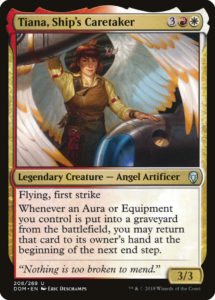
Fewer Knobs
There are twenty-two uncommon legendaries in Dominaria, of which twenty are creatures (the other two being On Serra’s Wings and In Bolas’s Clutches). They provide a variety of different play patterns and challenges. Some are innately powerful and require little work, like Raff Capashen, Ship’s Mage and Slimefoot, the Stowaway—and of course, Tatyova, Benthic Druid, who’s basically a Planeswalker. But they’re the exceptions, not the rule. Some enable their own archetypes, such as Valduk, Keeper of the Flame, Tiana, Ship’s Caretaker, and Kwende, Pride of Femeref. Others bolster existing archetypes, such as Shanna, Sisay’s Legacy and Whisper, Blood Liturgist. Others still are workhorses—the charming Yargle, Glutton of Urborg is a weak card with an exciting combination of stats, a wonderfully silly backstory, and just enough playability to support someone who really needs a legendary permanent.
If you look at these, you see a variety of play patterns and knobs. Urgoros, the Empty One and Grunn, the Lonely King are meant to attack. Garna, the Bloodflame is about setting up one incredibly explosive turn. Baird, Steward of Argive is defensive. Tatyova, Benthic Druid stays out of combat and takes over the game.
Planeswalkers don’t have power and toughness that can be fine-tuned. While creatures almost always provide some value (since they’re repeatable sources of damage and can often trade with an opponent’s creature one-for-one), Planeswalkers almost invariably provide multiple cards’ worth of value (making them incredibly powerful) or hardly any value (making them very, very weak). Planeswalkers generally push for the same play pattern: keep them alive, and if you do, you’ll almost assuredly win. It’s easy to make Tatyovas, but much harder to make Yargles, Garnas, and Grunns.
Planeswalking Populi
So, we’ve talked at length about what the challenges are about putting Planeswalkers in every pack. We also know that Wizards has found one, and likely several, solutions. Much of this I believe are things that have been intentionally held in reserve for just such an occasion.
Planeswalker design space is tight, but it’s generally followed a familiar pattern: a plus (that provides a small or negligible advantage), a minus (that almost always provides a card’s worth of value), and an ultimate (that usually needs to be built up to and often swings the game heavily in your favor). The power of these scale with a Planeswalker’s converted mana cost, but it’s a formula that’s holds true across the majority. However, there are things we’ve hardly seen done on Planeswalkers that I expect we’ll see much more of in War of the Spark.
Static Abilities, or Planeswalkers as Enchantments
We’ve seen almost no Planeswalkers with static abilities beyond “this can be your Commander.” I expect that to change. Imagine a Planeswalker with a very weak plus and mediocre minus with Levitation or Archetype of Imagination‘s text box always functioning in place of an ultimate. What if instead of providing Gideon, Ally of Zendikar‘s emblem, the new Gideon just provides that effect as long as he lives? He could also gain loyalty by turning into a creature and zero to make something attack him. This implementation, attackable enchantments, harkens back to the Structures from early Ravnica: City of Guilds design.
Triggered Abilities, or Enchantment Planeswalkers Redux
We’ve not seen Planeswalkers use triggered abilities beyond Garruk Relentless‘s ability to flip. So why not more? We could have a Circle of Flame Chandra that constantly protects herself and her allies, rather than having such an ability require a choice and not always function (like Jace, Architect of Thought‘s plus). Such a Chandra could even minus to power up that ability for a turn. We could have a Jace who remembers something every turn and whose ability to draw cards increases as he does, à la Mind Unbound. We could have a Vraska whose Induced Amnesia can be disabled, unlocking or charging up her abilities once you’ve jumped through a hoop.
Planeswalkers as Creatures
Creatures have perhaps the deepest design space in Magic and are the most important card type in Limited (beyond lands), so it’d make sense if some Planeswalkers essentially function as creatures. We’ve already got Jiang Yanggu and Nissa, Sage Animist that can only create a single, legendary creature token. What if this is their primary function? Imagine a four mana Jiang Yanggu with no ultimate, a weaker plus, and costing three loyalty to summon Mowu. He’d be a Hill Giant that might return once. This could be our Yargle—playable for those who need a Planeswalker, but not especially oppressive.
Planeswalkers as Sorceries
Many Planeswalkers already have the ability cast historically significant spells in addition to their pluses and quests for their ultimates. What if this were their primary function? Imagine a card like Vraska the Unseen with no ability to gain loyalty. She’d kill a thing, then have a zero loyalty ability to provide some minor advantage (like using Graveyard Shovel) until taken down. There could be a Jace that casts Divination once and then functions an Epitaph Golem forevermore.
I expect that this is the least likely implementation of Planeswalkers, since it feels so distinct from how planeswalkers function, but won’t be surprised if it shows up on a few. That said, I do expect many, if not most Planeswalkers at lower rarities to lack ultimates, or have ultimates that cast moderately powerful spells, like Lightning Blast, rather than Chandra Nalaar‘s mega Flame Wave. It’s just too hard to balance Limited when every player has guaranteed access to three bomb Planeswalkers, but if they’re mostly workhorse uncommons (as was the case with Dominaria’s legendaries), then we could have the makings of a very unique, and very awesome new format.
And there you have it. Four different ways that Planeswalkers could appear in War of the Spark at lower rarities and high density. I wouldn’t be surprised if some of the higher profile (and rarity) Planeswalkers function in more similar, game-upending ways, but expect that many will be more like Kazarov, Sengir Pureblood or Jaya Ballard (powerful, but with major restrictions) than Teferi, Hero of Dominaria or Karn, Scion of Urza (overtly powerful).
And, as always, thanks for reading.
—Zachary Barash is a New York City-based game designer and the commissioner of Team Draft League. He designs for Kingdom Death: Monster, has a Game Design MFA from the NYU Game Center, and does freelance game design. When the stars align, he streams Magic.
His favorite card of the month is Prophetic Prism, which is also his favorite design of all time. It’s a simple but powerful effect in Limited, allowing ambitious manabases while having nice synergies with mechanics like Improvise and sacrifice effects. Also, it always has absolutely gorgeous art.

